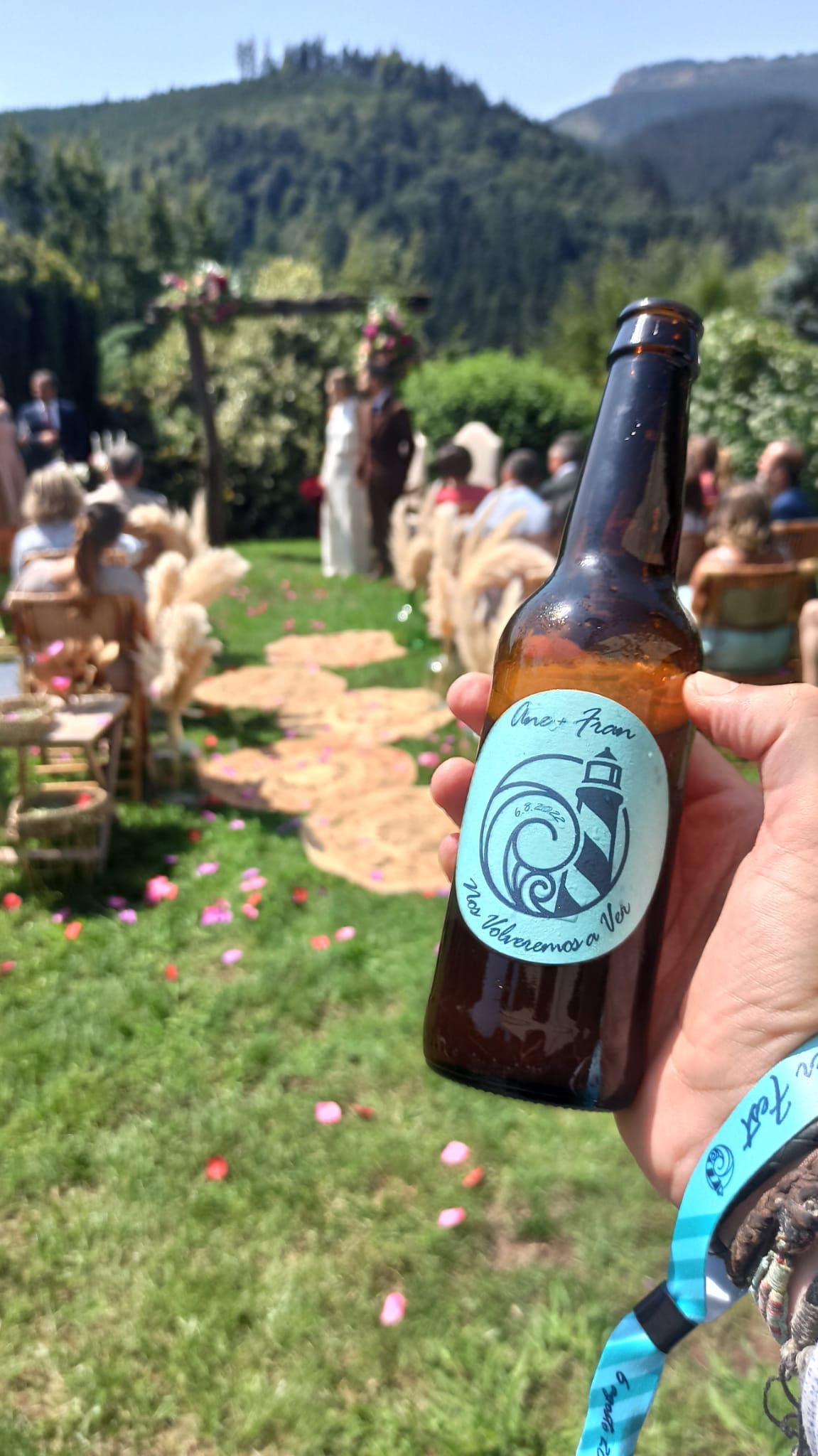38) Boga
Este verano he tenido una boda, donde 2 personas cercanas contraían matrimonio y en la ceremonia me topé con los siguiente botellines de cerveza serigrafiados con el logo de la boda. La cerveza estaba muy buena y al no aparecer ninguna marca visible, tuve que entablar conversación con los proveedores del evento para saber que se trataba de una cerveza artesanal llamada Cerveza Boga • Basque Beer. En los pueblos costeros que están enclavados en el litoral vasco, cuando los marineros zarpaban a la mar en busca de nuevas aventuras, gritaban “Boga”.
Me explicaron que son una cooperativa compuesta de 7 profesionales. Me contaron la receta donde no utilizan ni aditivos ni conservantes artificiales, y aquí os la dejo para que podáis compartirla con vuestra red de contactos.
Todo inicia mezclando la cebada malteada y agua (proporción 1:3). El objetivo es disolver el almidón que tiene la cebada. El almidón es una cadena de azucares muy largas, cadenas de glucosa unidas entre ellas. El objetivo del empaste es extraer ese almidón, en forma de azucares simples en el liquido. La propia cascara de grano tiene una encimas (alpha- y beta-amilasa) que catalizan la degradación del almidón. Para que esas encimas trabajen bien, el pH de esa mezcla tiene que estar en torno a 5,3. La T es también un factor a tener en cuenta, por ejemplo, la cerveza de la boda era Argia Pilsen lager (cerveza ligera) el empaste se hace a baja temperatura (63ºC).
El agua también tiene su miga, dado que en la relación sulfato/cloruros presentes en el agua, si en la balanza tenemos más sulfatos la sensación será más astringente. No obstante, si prevalecen los cloruros estaremos convirtiendo en una cerveza más dulce. En el caso de la Pilsen, la relación es pareja.
La pasta se agita dentro del tanque de maceración durante 1h. Este tanque dispone de un filtro en la parte inferior, que permite filtrar el agua al finalizar el proceso (el denominado mosto, por su alto contenido en azucares), para trasvasarlo al tanque de ebullición. Aquí se hierve durante 1h para sanitizar el mosto, y eliminar las bacterias. Se añade el lúpulo, que se va isomerizar para generar alpha-ácidos (componentes que le dan al amargor a la cerveza).
En este momento, es clave enfriar rápido el mosto con la ayuda de unos intercambiadores de calor, para pasar del mosto hirviendo a 20ºC.
La mezcla se oxigena e inicia la fermentación aeróbica a 13ºC. De una manera “burda” que diría aquel, la levadura se reproduce mientras consume el azúcar empleando oxigeno. Después viene la fermentación anaeróbica (o fermentación alcohólica sin oxigeno), donde la levadura convierte el azúcar en etanol expulsando CO₂.
Este proceso se puede seguir midiendo la densidad de líquido con el paso del tiempo, ya que, al desaparecer la glucosa la densidad desciende. Para terminar, la levadura se retira haciéndola precipitar, bajando la temperatura casi hasta 0ºC.
El proceso de elaboración está finalizado, solamente queda envasarla y disfrutarla.
38) Boga
This summer I had a wedding, where 2 close people got married and at the ceremony I came across the following beer bottles screen-printed with the wedding logo. The beer was very good and since no visible brand appeared, I had to start a conversation with the event suppliers to find out that it was a craft beer called Cerveza Boga • Basque Beer. In the coastal towns that are located on the Basque coast, when the sailors set sail in search of new adventures, they shouted “Boga”.
They explained to me that they are a cooperative made up of 7 professionals. They told me the recipe where they do not use artificial additives or preservatives, and I leave it here so you can share it with your network of contacts.
It all starts by mixing the malted barley and water (1:3 ratio). The goal is to dissolve the starch in the barley. Starch is a very long sugar chain, glucose chains linked together. The objective of the filling is to extract that starch, in the form of simple sugars in the liquid. The grain shell itself has enzymes (alpha- and beta-amylase) that catalyze starch degradation. For those enzymes to work well, the pH of that mixture has to be around 5.3. The T is also a factor to take into account, for example, the wedding beer was Argia Pilsen lager (light beer) the mixture is made at low temperature (63ºC).
Water also has its crumb, since in the sulfate/chloride ratio present in the water, if we have more sulfates on the scale, the sensation will be more astringent. However, if chlorides prevail, we will be turning into a sweeter beer. In the case of Pilsen, the relationship is even.
The paste is stirred inside the maceration tank for 1h. This tank has a filter at the bottom, which allows filtering the water at the end of the process (the so-called must, due to its high sugar content), to transfer it to the boiling tank. Here it is boiled for 1 hour to sanitize the must and eliminate bacteria. Hops are added, which will be isomerized to generate alpha-acids (components that give beer bitterness).
At this time, it is key to rapidly cool the must with the help of heat exchangers, to go from boiling must to 20ºC.
The mixture is oxygenated and aerobic fermentation begins at 13ºC. In a "crude" way that one would say, the yeast reproduces while it consumes the sugar using oxygen. Next comes anaerobic fermentation (or alcoholic fermentation without oxygen), where yeast converts sugar to ethanol, expelling CO₂.
This process can be continued by measuring the density of the liquid over time, since, as the glucose disappears, the density decreases. Finally, the yeast is removed making it precipitate, lowering the temperature almost to 0ºC.
The elaboration process is finished, it only remains to pack it and enjoy it.






